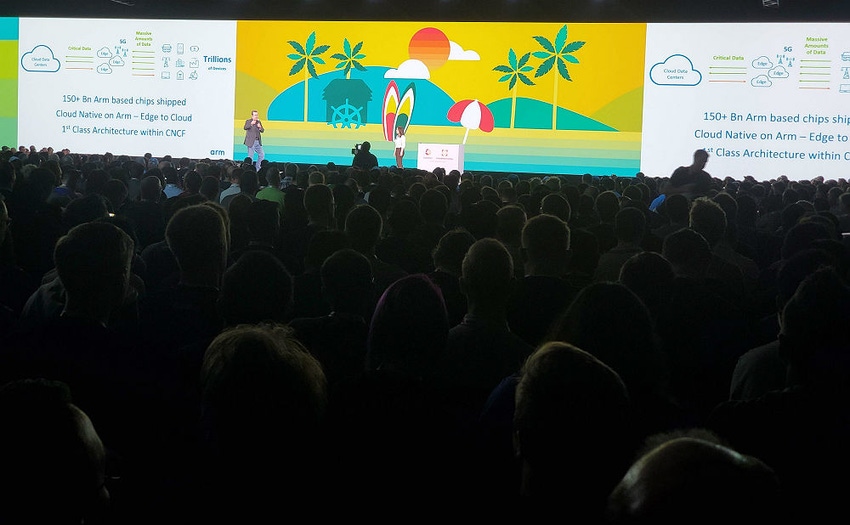Partners need to get on the Kubernetes bus soon to make it a larger part of their future success.
November 21, 2019

(Pictured above: A packed keynote at KubeCon 2019 in San Diego.)
KUBECON CLOUDNATIVECON NORTH AMERICA — As the Kubernetes container orchestration platform continues to mature and grow its business user base around the globe, HPE is working to build and promote Kubernetes as a critical tool that its channel partners can help spread to the masses.
To highlight that growing mission, HPE has unveiled its new HPE Container Platform, built to give developers secure and rapid access to their Kubernetes IT environments as well as easier provisioning and multicluster management for production Kubernetes environments. Announced earlier this week here at the KubeCon North America 2019 event in San Diego, the product is just part of the company’s plans for Kubernetes expansion, Robert Christiansen, vice president and chief cloud strategist in HPE’s office of the CTO, told Channel Futures.
Channel partners aren’t interested in Kubernetes just for the sake of the technology, he said, but they are intrigued because of how the platform can serve their customers and solve customer needs, said Christiansen. More and more partners have been discussing these scenarios with HPE over the last year as they work to understand Kubernetes and learn more about how it can be used to grow their services and revenue.
“Absolutely, but they’re looking for as an outcome,” he said. “They want to know how they can give their clients a set of services that they believe will accelerate their competitiveness in the marketplace … whether it’s SMB, midmarket and partners that handle the enterprise-level stuff.”
For midmarket and SMB customers, that will mean channel partners having to work to explain how Kubernetes can be solution-based in a wide variety of examples in vertical markets, said Christiansen.

HPE’s Robert Christiansen
“If HPE is going to continue to leverage the channel in a cooperative way that gives them a set of services that they can really deliver to their clients, that leverages the new virtualization model” involving the still maturing world of Kubernetes and containers, he said.
Today, the channel is mostly focused on virtual machines using VMware or Hyper-V, which is fine because partners are familiar with them and know how to sell, deploy and help manage them for customers, said Christiansen.
But to keep up with the growth and interest in the open-source Kubernetes platform, “the channel is going to need to pivot with the industry to be relevant,” he said. “So, it’s incumbent on HPE to bring them along with us in our strategy.”
For HPE, that means positioning its set of Kubernetes services well to give channel partners a huge leveraging point for their sales and services to customers, he said.
“Having Kubernetes as a name inside that space is more important than channel partners actually understand because of what that actually could do for them,” he said.
That process involves showing partners how to deploy applications on bare metal, including applications they have already put together for their clients. It also means showing partners other related opportunities that can help grow their services businesses using Kubernetes.
“If they want to deploy Kubernetes, including multiple clusters of Kubernetes across multiple platforms of infrastructure – which is a really good thing to do if you’re a channel partner – HPE can help them,” whether it is on public clouds or on premises and whether it is on HPE gear or Dell, Lenovo or other hardware.
“Having a channel partner who has the skills, the capabilities and the desire to be that service partner in those channels is absolutely critical for our success,” Christiansen said.
For SMBs to eventually become more intrigued by Kubernetes for cloud computing and have it trickle down to their operations in the future, the technology needs to become …
… even more turnkey, he added.
“You want to be able to offer a basic turnkey solution that may have this as the core piece of virtualization in it,” he said. “Let’s say that an SMB needs to have some sort of computer vision application that’s easy to use. Why not have a turnkey offering that lets them deploy that in a casino or in a retail environment? Or a secured environment that an SMB or a channel partner serving them can deploy and use that turns on that service? That’s a real powerful service.”
For many users, VMware and Hyper-V are fine for what they need, but when they want to move to Kubernetes, it’s more complicated and they likely need more handholding, which is why channel partners need to be a bigger part of this future, said Christiansen.
“This is where the value add of a partner really takes place,” he explained. “They are the domain experts in the verticals for these organizations that understand what it means to be running in a health care, hospital, small banking, life sciences, retail or other environment.”
The next part of HPE’s strategy, expected to come to fruition in 2020, is developing those turnkey Kubernetes products that will give partners more packages and customization capabilities to solve these IT problems for their customers.
“If you really think about the container platform, as a centerpiece of this, we have to provide a hardware and software stack to do it,” Christiansen said. “We’re in the process of that, where you take a set of HPE components that all work together and that are software-driven. This is an important software-driven stack.”
And instead of worrying about brands of hardware, the packages are sold in various sizes like in T-shirt sizes, from small to XXL, that allow the channel to give customers just what they need. Those packages will come with sets of exposed APIs that will allow partners to “wrap their own love around that platform,” giving them targeted packages for their customers.
“Now that’s power, right?” said Christiansen.
The process will put something in the channel that channel partners can put their fingerprints on, make their own, and then go out and add value and margin to what they already get working with HPE, he said. But more importantly, it will help partners turn offerings into SaaS models that can build client connections and recurring revenue.
“These are choices that the channel will see,” said Christiansen. “As the Kubernetes pivot with the channel happens, you’re going to see the same pivot that’s happening with HPE.”
About the Author(s)
You May Also Like


